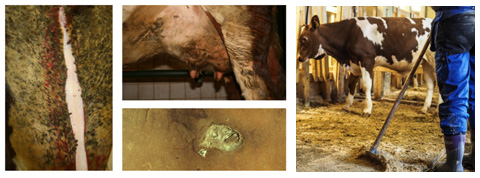Clean animals
It is generally regarded that clean animals and good slaughter hygiene are fundamental pre-requisites for meat safety for consumers. Faecal material that adheres to hides and fleeces might contain pathogenic bacteria. Slaughtering of dirty animals in a hygienically way, is more difficult and time-consuming than clean animals. Animal cleanliness is contributing to animal welfare, hygienic milk production, better growth, high-value skins, and positive reputation for agriculture and animal husbandry with the public.

Regulation
The global guidelines of Codex Alimentarius state that animals presented for slaughter must be clean. Also, regulation (EC) No 853/2004 and (EU) 2019/627 point out that animals must be clean and “AM inspection shall include verification of food business operators’ compliance with their obligation to ensure that animals have a clean hide, skin or fleece, to avoid any unacceptable risk of contamination of the fresh meat during slaughter.” A definition of “clean” is lacking.
Keeping animals clean
Preventive and corrective actions during rearing is necessary, such as shelter, dry feeding places, animal density in indoor pens, cleaning of bedding, bedding material, clean floors, air humidity, design of buildings, feeding and feedstuff, avoiding diarrhoea and keep the herd healthy. There are seasonal variations. To remove dirt, clipping, brushing, scraping, hair shedding and washing can be used.

Cleanliness systems in abattoirs in European countries
In some countries, there are routines and systems for categorisation of visual hide/fleece cleanliness and penalty of the farmers delivering dirty animals. UK has developed a system for cattle and sheep categorised according to Meat Hygiene Service Clean Livestock Policy (Food Standards Agency, 2007). Extensively dirty animals must be cleaned or may be even refused. Ireland (Doherty, 1999), Italy and France: tested systems, Finland (Ridell &Korkeala, 1993), Sweden (Swedish Board of Agriculture, 1998). Sweden has also developed a system for registration of visual contamination on finished carcasses for improving slaughter hygiene. In Norway, national guidelines for categorisation is developed, including penalizing of dirty animals (Hauge et al., 2011). Pre-slaughter actions have been tested, such as shearing in lairage, preslaughter chemical washing, hair-removing, diet or fasting.

Examples of category 0, 1 and 2 in Norway. Distributed on EUROP-classes for calves, steers, heifers and young cows.
Workshop:
Homework & preparation
The participants are asked to collect information from their own country prior to the workshop. If there is not a clean animal policy in your country, suggest a system. Prepare for the 7 questions.
Workshop in a virtual room
First, Sigrun will give a short presentation. Then, each participant is expected to provide an overview of clean animal policies in their own country or suggesting a system (homework). Thirdly, the participants will compare their findings and discuss the questions below. Finally, the participants will present what they have learnt in a 15-minute presentation.
Questions for homework and discussion in workshop
- What do you mean by “clean” animals? Suggest a definition.
- What can the farmers do to keep their animals clean in different production systems?
- Suggest the actions that you think have the best effect on cleanliness during rearing and before slaughter.
- What can the abattoirs do to secure meat safety when receiving dirty animals?
- Describe the system for clean animals in your country. If not, suggest a system. Discuss differences and similarities between countries in workshop.
- Describe how you would improve the system in 5) for reducing dirty slaughter animals.
- How can counties learn from each other on this topic?
Literature:
- Hauge, S, et al., 2012. Factors associated with dairy cattle cleanliness in Norwegian farms. Journal of Dairy Science, 95, 2485-2496.
- Clean beef cattle for slaughter. A guide for producers. Food Standards Agency.
- Cleaner cattle and sheep.
- Producing clean slaughter cattle. Technical note. SAC 1997.
- Clean cattle manual. Meat and livestock Australia.
- Clean cattle (in Norwegian).
- Livestock housing.
- Blagojevic, B., et al. (2012). Visual cleanliness scores of cattle at slaughter and microbial loads on the hides and the carcases. Veterinary Record, 170, 563-563.
- Manzi, et al, 2012. Relationship between teat-end condition, udder cleanliness and bovine subclinical mastitis. Research in Veterinary Science, 93, 430-434.
- Serraino, et al, 2012. Visual evaluation of cattle cleanliness and correlation to carcass microbial contamination during slaughtering. Meat Science 90, 502-506.
- Hauge S, Nafstad, Røtterud, T Nesbakken, 2012. The hygienic impact of categorisation of cattle by hide cleanliness in the abattoir. Food Control, 27, 100-107.

